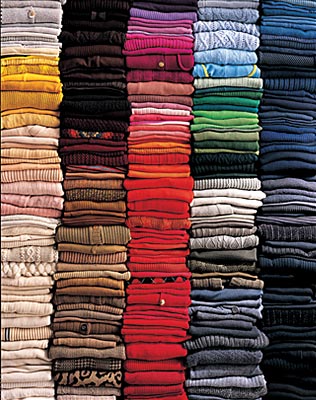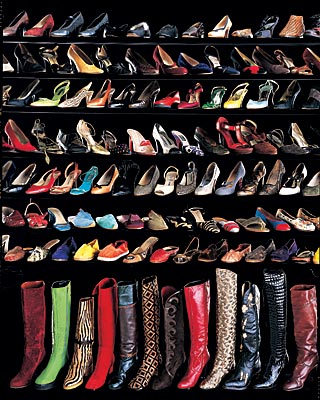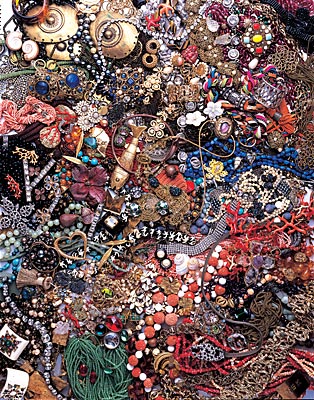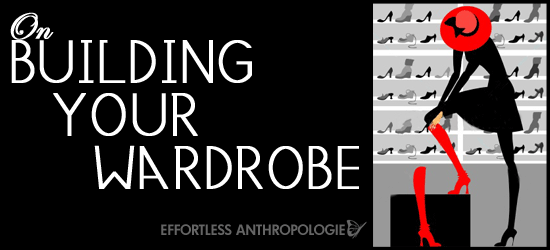It’s that moment many of us experience every single day: we are ready to get ready for our day, but our closet is not ready for us. We stare into a well-stocked, well-organized sea of tops, skirts, dresses, pants, shoes, etc. Yet not a single piece calls to us. Somehow, despite owning hundreds of items we cannot find a single thing to wear.
It strikes us all — stylists, professionals, stay-at-home moms, youngins, fashionistas. It’s not unusual to get bored of the things we own. What is unusual is how our culture has become so accustomed to using and disposing of our items, often before they are truly ready to be tossed, that we’re left in an odd and frustrating state where our clothing is still in good shape but feels useless to us. I can’t wear that, we think, it’s old! We say this to pieces less than a year old in our closets. But the worst is the feeling of I have nothing to wear with this. For many of us it’s a feeling we get over and over as we drift through our seas of clothing.
How do you transform your closet from a vast ocean of pieces to a flowing river of coordinated outfits? Read on for my thoughts and then please share your recommendations in the comments.
DO YOU OWN THESE CLOSET BASICS?
I know it sounds counter-intuitive to our overall goal, but if you don’t own a few wardrobe essentials you need to buy them. Not only will they help you put together more outfits among the clothing you have but you’ll feel less compulsion to buy new items knowing that you have some solid outfits already.
A famous designer once said that a woman’s wardrobe should be 80% neutral classics. Too much pattern or too many one-offs and you’ll find yourself without much to wear. How does your closet stack up to this threshold?
Knowing that this community encompasses a variety of age groups, take the following list as a general guideline that should be adapted to your lifestyle:
1. A pair of straight or boot-cut dark denim jeans
2. A striped shirt
3. A white tank or short sleeve tee
4. A neutral trench, preferably belted
5. A black sheath dress
6. A navy fit-and-flare a-line dress
7. A pencil skirt in black, navy or beige
8. A black or navy a-line skirt
9. A pair of comfortable walking flats in black or tan
10. A pair of equestrian boots
11. A functional bag in a warm brown tone like saddle or cognac
12. A neutral-tone scarf
13. A v-neck sweater in black or grey
14. A fitted crewneck sweater
15. A fitted cardigan in black, navy, grey or tan
These 15 items should all be of impeccable quality and fit. Truly they are investment pieces that if cared for properly and made well will last for years in your closet. They’ll be the foundations for hundreds of outfits. Don’t skimp on quality — invest in cashmere sweaters if your budget allows; choose structured wool dresses over polyester; ensure the pair of jeans you choose fits perfectly at the waist, hips and bottom.
Personally, I turn to stores like Club Monaco, Gap, J.Crew, etc to find these items. At the end of the seasons I hit the sales at Bergdorf Goodman, Saks and Bloomingdales to hunt down well-made designer pieces that fit the criteria above. Every now and then if I find an incredible piece that fits like a dream I will invest at full price.
If your budget is stretched thin, focus on fit. Department stores like Macy’s and Lord & Taylor often have fantastic promotions that help bring mid-range designer fashions down to a budget price point. If that doesn’t work, visit stores like Gap, Zara or H&M that are known for their basics while still maintaining modern, flattering fits. Don’t settle for any old black cardigan just because it’s within your budget. Invest in yourself — commit to hitting several stores as your time allows and find that piece that truly fits and flatters.
One tactic I can’t recommend enough is consulting a professional to help you find the right fit. Perhaps your favorite store staffs personal stylists (i.e. J.Crew or Anthropologie). Department stores like Bloomingdales or Nordstrom set appointments to help with personal shopping. Upscale stores have knowledgeable brand associates who have the current lines memorized and can help pick the perfect piece for you. Be up front about the reason for your visit: tell the staffer that you need help finding the right fit and choosing the most flattering shapes for your body. At the end of the day yes it’s their job to sell but they also get paid to help you look good. You don’t need to buy right away but an objective eye can be invaluable.
DO YOU OWN LOTS OF SIMILAR ITEMS?
Are you like me? Do you own 4 dark denim pencil skirts, 5 striped shirts, and 3 grey cable sweaters? Wonder why? Most likely, it’s because each of those pieces works well in certain outfits but not others. They can go with some items but not as many as you want. In other words, like me you probably settled. I impulse bought a skirt that was cute without truly thinking about its utility. I didn’t know how to find the right thickness of stripes that would truly flatter me, so I settled with 4 mistakes before I found the striped top that truly works. (And now I’m left with 4 others I don’t really need.)
The problem is that I can’t bear to get rid of those 4 other striped shirts. I still like them! And I have outfits they work in. It’s just that I like that 5th shirt so much that I hardly wear the other 4…
This is when you need to be honest and maybe a little tough with yourself. Do I really need 5 striped shirts? No. Does it hurt a bit to let go of tops I paid good money for? Yes. But hopefully the lesson learned here is that next time I’m looking for an item, I should keep looking until I find that perfect piece rather than just grabbing the option from my favorite store, or the piece that was too good a deal to pass up, or the top that everyone else owned.
Owning too many similar items creates mental clutter. When you go to form an outfit, isn’t it exhausting to have to choose from 20 blue pencil skirts to find just the right color, 10 floral tops to find the pattern you feel like wearing today, 8 gold necklaces of varying tones, 6 pairs of black pumps each with a different toe? I’m exasperated just thinking about it! It makes me just want to walk out in my nightie instead.
If you own lots of similar items, you need to cull. Commit to owning no siblings, no lookalikes with a twist. Set the goal for yourself: get down to one of each item type. If you can’t go down from your current number to 1, then start by culling 1. And then do it again next month. And the month after that. Keep going until your closet is a curated masterpiece rather than a sloppy symphony.
THE TYPES OF SHOPPERS
There is a discussion gaining steam among stylists right now about the types of clients out there. Are you a builder, a collector or a curator?
A builder is someone who is adding to their closet. Perhaps its your first go at building a professional wardrobe. Maybe your body recently changed due to a baby, or weight gain/loss, or perhaps a health issue. Maybe you’re just out of school, or just going to school, or starting a new job, or moving to a new location. Whatever the reason, your closet is growing right now.
During this phase the advantage is that you have no baggage. There probably aren’t many items in your closet you want to hold on to — you want to start fresh and do it right. The disadvantage is that it’s easy to fill up your closet with impulse buys and items that aren’t really what you need.
On the other hand, if your closet is already full but you still find yourself building, it’s time for a gut check. Why do you feel the need to keep buying and buying? It’s certainly normal to want to get a few new pieces each season. But if you can’t go more than a week without buying a new clothing item, this indicates a problem with your current wardrobe. That lack of satisfaction will keep driving you back to the store when you should be enjoying the items you’ve already purchased.
If you find yourself in this latter part of the builder personality, I recommend a closet cull followed by a strategic plan to help you enjoy your wardrobe. I will be addressing both of these in a subsequent post.
As a builder, here are some of the key questions to ask yourself:
0. Can I afford this item? (This should always be the first question you ask, so basic it’s before 1.)
1. Do I own the necessary wardrobe basics?
2. What is my personal style? Do I tend towards a boho vibe, or a downtown style, or a preppy bent?
3. Where will I wear this item?
4. How long can I see myself owning this item?
5. What pieces will I need to create an outfit with this item? Am I willing to buy those pieces?
Builders need to have a set stopping point in place or they can go on building forever. Be discerning in your purchases. Have a goal in mind for your wardrobe (i.e. I will buy two new work outfits this season) and stop when that’s accomplished. Don’t stray away from your goal. It’s always fun coming home with shopping bags, but that joy will be short-lived if you’re not truly happy with items wrapped so wonderfully within.
For the record, I find myself stuck in the building phase. I constantly feel the need to purge out items that feel old to me (even though they probably aren’t) and invest in new just so I can feel up-to-date. Sometimes I come home with shopping bags and then realize what I’ve bought is not truly what I needed.
—
A collector is someone whose closet is something like a museum. Collectors commonly have large clothing collections, usually with some pieces in storage. If their collection is not large it is probably filled with pieces they feel attached to rather than truly functional items. They have an emotional connection with their pieces, often remembering where and when they purchased each item. Their closet may have items they no longer wear but love to show off. Friends recognize many pieces from somewhere, be it a magazine, a blogger, or perhaps even a celebrity. Their wardrobe may be glamorous in sheer number of items owned or perhaps in ornateness or detail of the items.
Often collectors have a section of their closet devoted to this season’s trends — items they saw someone else rocking or that they see a lot on the streets. Perhaps all their friends own cropped jeans so the collector needs a pair too to fit in. Next to this closet section is an ever-growing collection of season’s past trends — items they are hoping will come back into fashion so they can be worn again.
Collectors sometimes they buy pieces they never wear because those items are popular, or highly coveted, or hard to find. Later on they will look at these pieces and wonder, Why ever did I buy this? Yet even with that recognition it is hard for the collector to let go of anything. An item that doesn’t fit today may fit in two months. A piece that was trendy two years ago is sure to come back into favor. The dress they wore on a significant date simply can’t go — it means too much.
For the collector, the challenge is turning that emotional connection from a short-lived boost of hooray, I acquired this! to I will wear this piece forever. Collectors are often bored by neutrals and classic pieces because those items don’t fit their vibrant personalities. But unless you have an unlimited budget and closet space, being a collector often saddles you with the emotional baggage of having many clothes to care for that may not fit day-to-day life. That can keep you from truly enjoying those special pieces that you own.
As a collector, here are some of the key questions to ask yourself:
0. Can I afford this item? (This should always be the first question you ask, so basic it’s before 1.)
1. When was the last time I wore this item?
2. When can I see myself wearing this item again?
3. Do I want this item because it is beautiful, or do I want it because I will wear it?
4. Do I want this item because it looked good on someone else, and does it look as good on me?
5. If I lost this item, would I truly miss it? Would I miss it enough to rebuy it?
For collectors, the challenge is resisting the desire to buy an item that is gorgeous to look at but not so fun to wear. To abstain from the trend that doesn’t fit your lifestyle. To build your own fashion identity that allows you to confidently decide whether an item is a good complement to items you already own.
A great rule for collectors is the “one item in, one item out” rule. This means that for every item of clothing you buy, something must be retired from your closet (sold, donated, trashed or recycled if in bad condition, whatever). It’s not easy. The temptation to just buy more hangers will always be there. But a collector will be happiest transitioning to a curator, our next style.
—
A curator is someone who treats their closet like a fine boutique, constantly refining, redefining and recycling their wardrobe with aplomb. The curator knows when they purchased each item, how much they paid, and how many times they have worn the item. They may have a separate section of their closet for items they wear most often, or particularly successful outfits. A curator is tempted to wear the same outfit two days in a row if it worked very well or cleans a great look right after wearing it so it’s quickly ready to go again.
Curators may not be completely satisfied with their closet, but they take such pride in their items that most of them are at least 3 years old. Rather than discard items the curator first tries to “remix” them — perhaps a cashmere sweater that they always wear over jeans can be belted over a maxi instead, giving it a new lease on life. Curators almost never shop without a list, and they hardly ever deviate from what’s on that list. They pay attention to trends in terms of silhouette and fit but tend to reject this season’s hottest pattern in favor of the new black (which of course, is black).
Pattern-loving curators tend to focus on smaller patterns in classic shapes like tiny birds, polka dots of a small to medium size, lace detailing and scallops. Their closet may appear mostly a boring concoction of navy, black and grey to outsiders but the curator has mixed in colorblocking, stripes and pattern for visual interest.
The curator’s closet is often organized by color, or shape, or a combination of both. Nothing delights a curator like rediscovering an item they somehow forgot about, be it a black dress or a pair of denim shorts or a fit-and-flare patterned frock. These cases are rare though. A curator tends to look at new clothing a lot but only buys a few pieces per season, usually when something they own wears out for good. When a trend truly catches them, the curator often makes room by passing on pieces to friends who gleefully accept the flattering discards.
As a curator, here are some of the key questions to ask yourself:
0. Can I afford this item? (This should always be the first question you ask, so basic it’s before 1.)
1. What on-trend items will last for a few seasons, and should I consider them for my closet?
2. Is my cost-per-wear of this item low enough that I can replace it with something newer?
3. Does this item still look modern or classic in shape?
4. What colors are missing from my closet?
5. How has my style changed over the last 3 years, and where do I see my style 3 years from now?
Curators admire trends from afar and often have trouble buying new things. As a result they’re sometimes stuck in classic colors or patterns that are in outdated shapes. It’s hard for them to break out of their shell and they don’t know how to ask for help. The hardest season for a curator is one filled with trendy colors, when their closet suddenly seems like a boring moldy mess and they are tempted to just trash everything and start over. With some guidance about how to incorporate trends in small doses, crisis can be averted.
—
Knowing what kind of shopper you are can help you break bad habits or keep you from forming new ones. But what if your closet is already full, and you’re happy with everything, but unhappy because you have nothing to wear?
HOW TO DISCOVER OUTFITS IN YOUR CLOSET
Before you start getting rid of items and starting the hunt again, here are some preliminary steps you can take.
1. ORGANIZE YOUR CLOSET
I’ll tackle this more in-depth in another post. But if your closet is a mess then your outfits might be too. I sympathize with people dealing with small closets, shared closets, or dark closets. Take the time to make your clothing as accessible and visible as possible. Part of caring about your appearance is making sure your clothes look their best too. If you’re stuck on where to begin, start by organizing your items by type (i.e. dresses to the left, then skirts, then tops).
OR, if you’re like me and tend to dress across styles (feminine/preppy/rockstar/delusional), try sectioning off your closet by style. Keep all the classics in the middle where you’ll see them first and use the sides for pieces you wear less often. Within each style then organize by type. You may find two pieces that work together that were never close enough for you to think to pair them.
2. GET A FRESH EYE ON YOUR CLOTHING
Do you have a fashionable friend who can help you make some new outfits? Or someone you trust to help you put together a look? My friends and I sometimes have closet parties where we invite 3 or 4 boys and gals over. Their mission to earn their wine? Go through my closet and put together 2 outfits you’ve never seen me in. Oftentimes my friends will pair items I’d never considered wearing together, thus yielding me a fresh-feeling look at a grand cost of one bottle of wine.
3. HUNT DOWN ITEMS YOU OWN ON POLYVORE & DO IMAGE SEARCHES
When I’m feeling lost about how to wear an item, I turn first to Polyvore for outfits. (You don’t have to be a member to look at sets.) I use Google to look up the product name on Polyvore. Let’s use the Changing Stripes Dress as an example. I search for it like so in Google:
“Changing Stripes Dress site:www.polyvore.com”
Voila! The second search result is the item page, which shows me the one set using that item. When that fails me I’ll do an image search for the item and hope to the fashion gods that someone more stylish than me wore the piece in some amazing way.
4. START WITH BASIC ITEMS AND WORK FROM THERE
If you are at a loss for what to wear, find that basic navy top or that classic white tee and work from there. Yes your outfit may be a bit more “boring” than you like but at least you will look put together. Pair neutrals and carry a bright bag, or wear colorful shoes. Whatever breaks you out of that rut.
5. PICK OUT TEN OF EACH CLOTHING ITEM TYPE, AND PACK EVERYTHING ELSE UP
The idea behind the 30-for-30 challenge is mainly remixing items, but a secondary benefit is that it causes you to identify your most versatile items. (How many of us have just picked our 30 favorite items, only to exhaust the outfit options by day 5?)
I’m modifying that a bit here — pick 10 dresses, 10 sweaters, 10 tops, 10 bottoms. Your ultimate goal is to make outfits of course but maybe start by picking your favorite items, or what you think are the most versatile. Once the initial 40 are chosen now try making outfits out of those items. Swap out items that don’t work at all or just work with a couple of things. Keep doing this until you’ve got the best assortment possible.
NOW PACK EVERYTHING ELSE UP. Commit to living with those 40 items for 3 weeks. At the end of those 3 weeks, what items did you miss? What items do you realize you need? What are you ready to part with? Which of the 40 did you not wear?
6. WHEN YOU WEAR A SUCCESSFUL OUTFIT, HANG THOSE ITEMS TOGETHER
Ever wonder why retail stores have outfit-assembled mannequins? To inspire us to buy all of those pieces as we know. So why not do the same in your closet? If you wear an outfit that truly rocks why not hang those items together after they’ve been cleaned? I do this with 4 or 5 of my favorite works out and nothing is better on those I have nothing to wear days than a great-looking outfit that’s ready to go.
This is just the tip of the iceberg! I’ll dig in more as this series continues. For now I’d love to hear your thoughts! Do you own all of the 15 basics I listed above? Which type of shopper (builder, collector, curator) are you? How do you find outfits in your closet?






